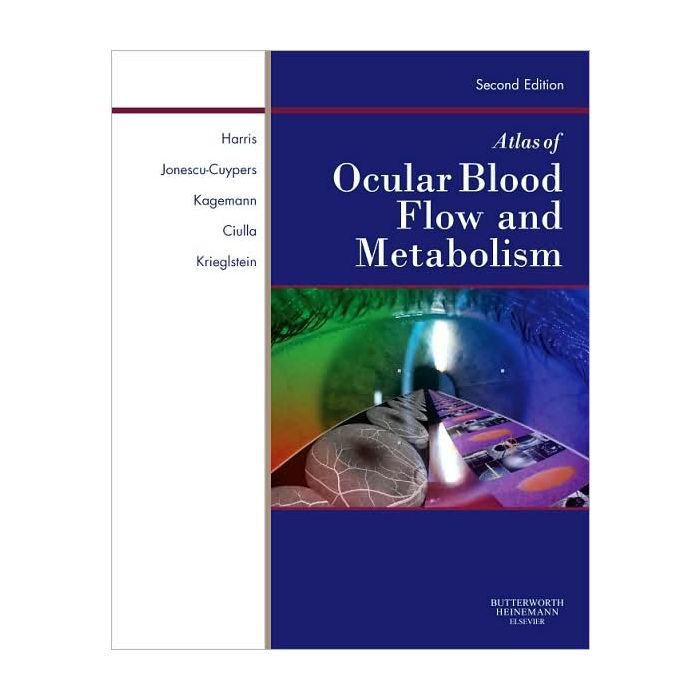Atlas of Ocular Blood Flow, 2nd Edition Vascular Anatomy, Pathophysiology, and Metabolism

- ISBN/EAN
- 9781437717372
- Editore
- Elsevier Science
- Formato
- Brossura
- Anno
- 2010
- Edizione
- 2
- Pagine
- 160
Disponibile
77,99 €
Description
This text examines the vascular anatomy and physiology of the eye as well as the assessment of ocular circulation in health and disease. It offers a cutting-edge analysis of the eye's blood supply and how it is affected by conditions such as glaucoma, age-related macular degeneration, and diabetic retinopathy. 425 illustrations -- including 250 in full color -- detail anatomy, techniques, the results of imaging studies, and more.
Reviews
-"This is an informative and richly illustrated atlas that contains practical and useful information about normal and abnormal ocular blood flow and its assessment. This book will appeal to clinicians and scientists with an interest in ocular blood flow. Also, the atlas will provide essential information for trainees with a special interest in the field."
--Graefe's Arch Clin Exp Ophthalmology, 242:687, 25 June 2004
Key Features
-Gain a clear understanding of the anatomy/physiology of the blood supply to and within the eye to help make more effective clinical decisions.
-Analyze the potential effects of blood flow changes in various eye illnesses to see how they are influenced by diseases like glaucoma and age-related macular degeneration.
-Rely on the extensive experience of the authors in implementing new technologies to better access ocular circulation.
Maggiori Informazioni
| Autore | Harris Alon |
|---|---|
| Editore | Elsevier Science |
| Anno | 2010 |
| Tipologia | Libro |
| Lingua | Inglese |
| Indice | I. Ocular vasculature, anatomical structure and function 1. Anatomy (different illustrations on anatomical structures in the orbit) a. Description of vasculature (and anatomic variations) beginning from the heart to the ophthalmic vein b. Innervation 2. Vascular physiology: Controls in general terms a. Innervation b. Autoregulation (e.g., intracular pressure) c. Relationship between blood pressure and blood flow in these vessels d. Intraocular pressure and blood flow to these vessels e. Different influencing factors (e.g. mediators of vessel dilation, vasoconstrictors) with diagrams showing affection of vessels 3. Pathophysiology a. Loss of innervation (Horner syndrome b. Ion channel dysfunction (theory) c. Vasospasm (clinical observation, cold hand, migraine, raynaud) d. Gas perturbations (hyperoxia, hypoxia, hypercapnia) and pharmacology II. Principles of technology (including diagrams) 4. Ultrasound a. Physical basics and anatomical description with illustrations b. History/early measurements c. Contemporary measurements d. Clinical examples 5. Angiography a. Physical basics and anatomical description b. History/early measurements c. Contemporary measurements d. Clinical 6. Laser Doppler technologies a. Physical basics and amatomical description b. History/early measurements c. Comtemporary measurements d. Clinical examples 7. Pulsatility based techniques a. Physical basics and anatomical description b. History/early measurements c. Contemporary measurements d. Clinical examples III. Principal applicability to diseases (examples of altered circulation) 8. Glaucoma (visual acuity, contrast sensitivity, visual fields, blood flow) a. POAG b. NTG c. CACG d. Other; one image per subdivision 9. Age-related macular degeneration a. One photo per stage, beginning with pigment shift, ending with subretinal meovascularization 10. Diabetic retinopathy 11. Arteriitic and non-arteriitic ischemic neuropathy 12. Vascular occlusions a. Arterial occulusion b. Vein occlusion c. Partial vessel occlusion (one-vessel-branch) d. Remaining macular vessel 13. Infections a. Histoplasmosis b. CMV c. Toxoplasmosis d. Any other infection related to blood flow disorders 14. Degenerative diseases a. Retinitis pigmentosa b. Any other disease related to vascular disorders (eg, vaskulitis) IV. New techniques and their future application |
Questo libro è anche in:
